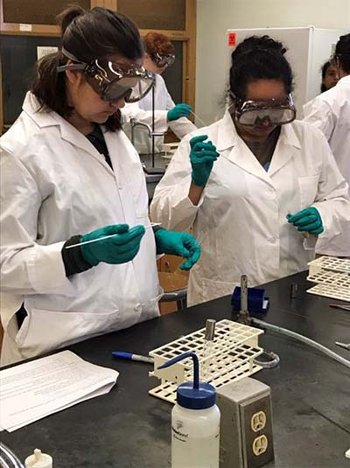
Academic medicine has made great strides in recent years to promote and achieve a diverse workforce that represents the diversity of our patients and ensures health equity across the continuum of care. Yet, data show that there is still work to be done in meeting this need. Pipeline programs supported by the Health Resources and Services Administration (HRSA) under Titles VII and VIII of the Public Health Service Act, as well as other federal programs, are proven solutions to addressing these issues, and help promote a culturally-competent, diverse, and prepared health care and biomedical research workforce that will enhance patient care and ensure health equity.
A June 2018 congressional briefing, hosted by the Congressional Academic Medicine Caucus (CAMC) and the AAMC, highlighted examples of innovative workforce diversity pipeline programs. Speakers included Maria L. Soto-Greene, MD, vice dean, professor of medicine, and director of the Hispanic Center of Excellence at Rutgers New Jersey Medical School; Ambika Mathur, PhD, associate provost for scientific training, workforce development, and diversity, dean of the graduate school, and professor of pediatrics at Wayne State University; and Helen Burstin, MD, MPH, FACP, executive vice president and CEO of the Council of Medical Specialty Societies. CAMC cochair Rep. Kathy Castor (D-Fla.) was on hand to provide remarks and underscore the importance of these programs.

Soto-Greene came from a disadvantaged background to become a successfully practicing physician and participated in the Health Careers Opportunity Program (HCOP), which is managed by HRSA under Title VII and was recently proposed for elimination in the House Labor-HHS appropriations bill. Her story is just one example of the power of pipeline programs.
“Others identified me so that’s why I have dedicated my life to identifying others,” said Soto-Greene. “We don’t always know our own potential, so that’s why these programs are so important.”
While in medical school, Soto-Greene served as a teaching assistant in the HCOP program, and she now serves as a coprincipal investigator at Rutgers on grants under the HCOP program that support the Northeast Regional Alliance (NERA) MedPrep Program.
The NERA MedPrep Program is a federally-funded initiative that brings together four medical schools — Rutgers, the Columbia University Vagelos College of Physicians and Surgeons, the Icahn School of Medicine at Mount Sinai, and Donald and Barbara Zucker School of Medicine at Hofstra/Northwell — and community-based organizations to better prepare young students from underrepresented groups and economically disadvantaged backgrounds for health care professions. NERA MedPrep has seen 362 students graduate from the program in the nine years since the program began, 176 of whom have been accepted into medical school and 32 of whom graduated medical school and entered residency.
Much like NERA MedPrep, the ReBUILDetroit Training Scholars Program at Wayne State University has provided an avenue into medicine and health care for underrepresented minorities. The program, funded by the National Institutes of Health Building Infrastructure Leading to Diversity (BUILD) Initiative, focuses on putting students from underrepresented backgrounds who are interested in biomedical research in an accelerated pipeline program that allows them to get both a bachelor’s and master’s degree in five years while simultaneously gaining significant research experience to prepare them for a PhD program. This program anticipates a 100% six-year graduation rate, compared with 20% for all other underrepresented students at WSU.
Mathur, principal investigator on the grant that funds ReBUILDetroit, also mentioned that Wayne State University is leading the way in creating a holistic review of the PhD admissions process, and evaluates possible PhD students using a portfolio that assesses a variety of factors rather than relying on standardized test scores, which have been found to be culturally biased towards underrepresented students.
While the programs highlighted at the briefing focus on high school and college students, other programs focus on younger audiences. “It is essential to start the pipelines at the K-level and to grab and sustain a connection at every level,” said Mathur. Soto-Greene and Burstin also noted that early entry into these pipeline programs is critical, which is why connections between academic medicine centers and local elementary and middle schools are just as important as connections with high schools and colleges.
During her presentation, Burstin said that programs like those described by Mathur and Soto-Greene can go a long way in addressing health disparities experienced in many underserved communities. Social determinants of health often drive health disparities, which lead to worse patient outcomes for disadvantaged individuals. By increasing the number of physicians from these backgrounds, the roots of these social determinants can be addressed.
“The more diverse the health care workforce, the more health care professionals can talk about these issues,” Burstin said. “That’s why pipeline programs are critical at all stages. By supporting them, we can provide better care.”